|
by Bob Roberts |
Locks... locks... locks! I don't know why, but this is a topic that comes up repeatedly week after week and although I posted several replies in RGVAC in the past, the questions still keep coming... not just newbies, either. Anyway, I guess I wasn't as thorough as I thought I was, so I will give it another shot right here where I can point to it :-)
The diameter of the mounting hole for standard cam locks is 3/4" & is usually in a double "D" shape on metal doors. Double "D" simply means that there are two parallel sides left in the circular hole to prevent the lock barrel from spinning around as it would in a 360º cutout. Jeez... that sounds a little oxymoronic, so I guess a pic is in order, already. I'll put pics below of double "D" plates used to prevent the locks from spinning when you mount them in a wood door after you've drilled your 3/4" whole hole:)
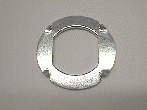



The first pic on the left is just a simple double "D" with four notches that bend out to a 90º angle to act as an anchor into the wood itself when you tighten down the mounting nut. This type often gives under a little pressure & ends up spinning (turning) in the mounting hole. The second pic shows one with the 4 little *tacks* and two holes for using screws for additional staying power. Now the third one is strong enough to actually cut out the remaining portions of metal on it to make it into a full circle after mounting it to the wood on the cab. The final pic shows where the term 'double "D"' comes from. K... we're through the wood & off to grandma's :-)
The cam locks are sold by the length of the locks. This is measured from the lip that prevents it from just passing through the mounting hole & out the other side, to where the actual cam mounts on the opposite end. The sizes as used over the years in coin-op range from 5/8" [a less common type most notably used by Nintendo & in vending machines] to 7/8" [the most common one used on a vast majority of coin doors] to 1 1/8" [ very common to accomodate the 3/4" deep wood back doors on vid games] to the final 1 3/8" [ primarily used in jukeboxes to access levers for multiple cam latches], but for vid games the two typical lock sizes of 7/8" & 1 1/8" will handle all your needs.

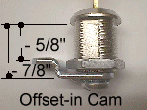
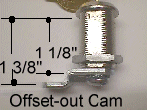
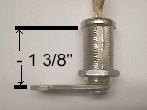
The 7/8" lock above has an offset-in cam attached showing how it can be used in place of a 5/8" lock. The 1 1/8" lock has an offset-out cam attached showing how it can be used to replace the 1 3/8" lock. Of course, you can swap them around to be used to replace each other, i.e., the 7/8" with an offset-out will replace a 1 1/8" lock and the 1 1/8" lock with an offset-in cam can replace a 7/8" lock.
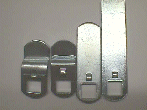
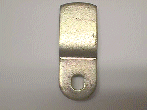
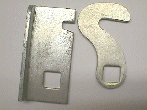

The pic on the far left above is of a few sizes of standard cams with stops. The second pic is of a cam that typically goes with an Ace, Gem or other brand of high security locks that ops often put on their machines to stave off break-ins. I wouldn't recommend using this type for your games as they are case hardened & require a special $40 circular drill bit to remove them if you lose your key & have no alternate means of entry available to you. As though that were not bad enough, the bits are typically good for two lock removals before their teeth fall off. I'll put a pic of the lock and the bit below. The third pic above is of a couple different cams used to hold down cocktail cabinet tops... or also used to latch down jukebox lids, vending machine doors and a variety of other coin-op uses. The fourth & final pic is of a common ridgid type cam used for back doors on the vid games & juke cashboxes. Very rugged cam... to the point of most lock cylinders breaking off before they break with any attempts to break-in through the cabinet back door :(

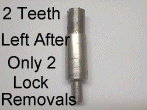
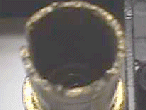
Incidentally, I tried to buy these drill bits above from local locksmiths & was refused, so I hunted down a locksmith supplier thinking that I could buy these from them.... no sale once again! I mentioned it to one of my customers, who as it turns out, just happens to be a locksmith :-) He bought some for me locally & found an out-of-state supplier for me. Just one more good reason not to use this type of lock on your home games.
I guess it's time for me to paste some of my original texts in here to save a bit of time. If I get any more first time questions about locks I'll be sure to add the reply here, as well.
Bally/Midway coin doors & most all over/under coin doors use the 7/8" cam lock set with a 1 1/8" straight cam. You can use the 1 1/8" cam locks in place of them by going to the ¼"offset-in cam. All this does is make up the ¼" difference in barrel length between the 7/8" barrel & the 1 1/8" barrel. Some of the older games used the 5/8" cam locks with a straight cam & again, you can go up a size to the 7/8" lock set & use the ¼"offset-in cam to make up the difference.
Back doors are most commonly 1 1/8" locks with 1 3/4" straight cams. There are exceptions that need the ¼"offset-out cam to get past a center door stop, or use a 1 3/8" lock set with a straight cam. There are also a few that use the 7/8" lock set with either the straight or ¼" offset out cams as they are recessed into the back doors' wood to allow for barrel length differences.
Some brands of lock sets use cams that are reversible & used as either offset-in or out as they have no stop tab. 90º movement is accomplished by a notched spacer which can be any degree from 90º to 270º which is placed on the end of the barrel & the stop tab is actually on the barrel housing rather then on the cam itself. Cams with the stop tab can be used in reverse situations, but they will spin 360º with the key in place...no stops. However, if they are used in reverse on a barrel stop type, they will work just fine.



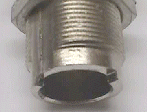
Once installed, you can have slop on most of them and the best way to remove it & get a tight door fit is to remove the control panel and lock the coin door. Pushing in on the coin door you can now eyeball or measure the distance between the cam & the door strike. It is tempting to just grab a pair of pliers & bend it in to meet the strike, but this will do several things. First it will mar up the cam at the very least & there is a danger of breaking the retaining screw in the end of the barrel, and secondly, if your barrel is a strong one, it will bend your coin door front out of flush.
The best way to do this is to remove the cam taking note of the direction you need to bend it in. If you have the luxury of a bench vice, you can put a couple pieces of paneling in it to act as a cushion so you can place the cam in between loosely and using a pair of pliers on the barrel end of the cam, gently bend it to the position you need & then retry it on the door.
If you have no vice or are on location for ops, you can grip the cam in the same manner with the pliers on the end that goes over the barrel, and place the end of the cam on a concrete floor or sidewalk & step down on the pliers with your foot to accomplish the same bend without screwing everything up. In my younger days I use to do this with 2 crescent wrenches more or less freestyle in the air, but as I got older, I wasn't able to handle the quick punches to the chest when one of the wrenches would slip off the cam :-( There were not as many slips when using them in conjunction with the vise, but again, it can be mean if you slip off the cam. I remember ripping my knuckles open on one such occassion and how painful it was, but they do a nice job bending the cams if you are careful.... and young & strong doesn't hurt, either :-)
The jaws of the pliers in both cases aide in protecting the barrel end of the cam from bending out of shape & not seating back onto the barrel properly.
Once your top door is tight in the over/under case, you will want to make a duplicate cam for the bottom door & once you have both secured you can replace your control panel.
The same applies to the back door with the exception of measuring the distance you want to tighten. First install the closest fitting lock set to needed & then turn the key to an almost locked position and pull on it to see the distance the back door will pull away from the cabinet to judge how much of an offset bend you'll need in the cam to make for a tight fitting door.
That said, if your coin door is just a tad off & you use care, you can tighten them while mounted with a crescent wrench. I'll put another pic below to illustrate this, but it is not a good idea to try this on back doors since so many are made from pressed wood, particle board or chip wood that any measurable force applied can actually give you a handful lock with a trapezoidal or pie-shaped piece of *wood* attached to it :-(
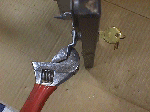
Another question that arises from time to time, is 'can I salvage any of these old locks that I have removed?' & the answer is yes. You can make an old spare key fit a lock that uses the same type of key, i.e., the key must fit into the barrel, by filing notches where needed & filling in unneeded ones with solder after wire brushing for adherence. You can remove some of the pins from the cylinder... down to just 1, if you want... or simply move them around to needed positions if you want to keep it intact. Saving any of the pins will insure that you have a properly spaced one available for your next experiment. BTW: You need to watch for flying tiny springs that are used for returns on the pins, also.
Another thing that I have saved over the years is all those keys! I don't know how many times they have come to the rescue on a machine that was without keys & impenetrable.... always something where a chain saw was just out of the question :O Give the new guy the box of keys & let him have at it! I've had many a first try and many a last tried key pop 'em open like magic. (Always wanted to go to the racetrack on those lucky days :-)
Here's a few ways to get into a machine without keys or a chain saw...
another often repeated question. Some vids are easy & by simply removing the marquee & flo, standing on a chair with a flashlight you can then see the screw that holds the cam to the back door lock... remove it & in turn do likewise to the coin door lock from the now open back door. Note: Have a catcher in the back of the game for the falling door. If you find that the screw or nut is just too tight for you to loosen, sometimes the 2 screws that hold the double "D" plate can be removed & the whole lock spun to effect the opening.
If your vid has the 2 recessed plastic handles in the top back you can sometimes remove them & by reaching in through the holes with a short screwdriver & feeling your way around, find the back door cam screw & remove it for opening.
Sometimes just carefully looking over the back reveals some portion of the back that is simply screwed on & can be removed for access to the game.
If you have only the coin door key.. or it is open... and you need to gain entry into the back or the cashbox, you can remove your CP & monitor glass to access other areas... sometimes going as far as removing the monitor itself, if it is a front mounted one. The entire over/under assembly can usually be removed by backing the retainer clip screws out & pushing in on the retainer clips. Here's a pic of another useful tool in this situation :-)

March 2008... How long have Alice & I been here helping out... hmmm... maybe a fresh look at our grandson Jon, above, as he appears today will help with a time line!
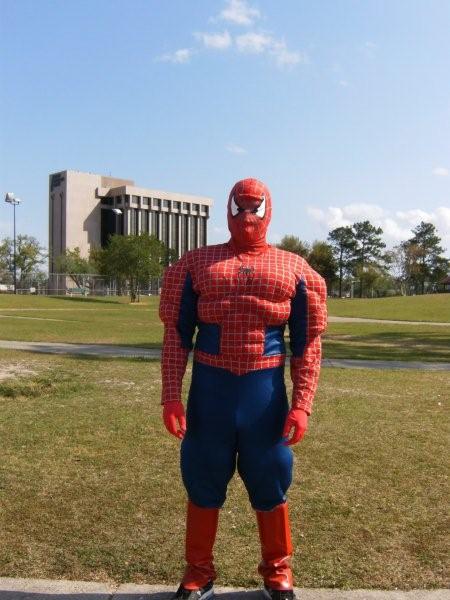
Hopefully this will provide the answers you're looking for pertaining to cam locks. The locks are available on the Parts Page under "Hardware" if you're looking for new ones.
Help Page Index Big Bear's Bulletin Board Site Index